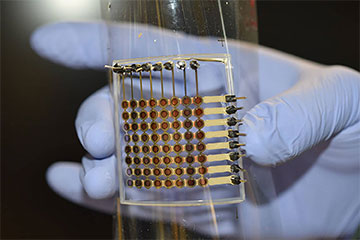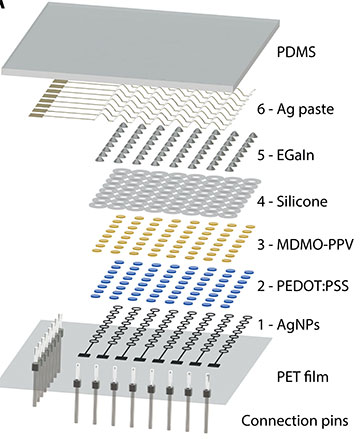
The fully 3D-printed, flexible OLED-display prototype is 1.5 inches square with 64 independently functioning pixels. [Image: McAlpine Group, University of Minnesota]
Organic LED (OLED) displays are poised to replace liquid crystal displays (LCDs) because they are thinner, more flexible, more energy-efficient and lighter, and because they offer a better high-contrast image with a full viewing angle. However, much as with LCDs, manufacturing OLED displays requires cost-prohibitive cleanroom microfabrication facilities. Now, a team of researchers from the University of Minnesota, USA, hopes to bring affordable OLED-display manufacturing to anyone with a 3D printer (Sci. Adv., doi: 10.1126/sciadv.abl8798).
Using a dual-mode printing technique on a single 3D-printing device, the researchers created a prototype of their flexible OLED. Ruitao Su, first author of the study, said in a press release that the proof-of-concept display “exhibited a relatively stable emission over the 2,000 bending cycles, suggesting that fully 3D-printed OLEDs can potentially be used for important applications in soft electronics and wearable devices.”

Schematic of the flexible, fully 3D-printed OLED-display prototype. Using a single device at room temperature, University of Minnesota researchers printed the electrodes, interconnects, insulation and encapsulation layers with an extruder attachment; the active layer of electroluminescent MDMO-PPV was printed with a spray nozzle attachment. [Image: McAlpine Group, University of Minnesota]
OLEDs: From factory to desktop
Engineers have attempted to make more cost-effective OLED displays through 3D printing, but have had to rely on spin coating or thermal evaporation to produce the uniform light-emitting layers integral to display function.
By adding a spray nozzle attachment to its 3D printer and using an electroluminescent polymer as the ink, the Minnesota team was able to print a highly consistent light-emitting layer for its OLED display. The other five device layers composing the OLED were printed using the same device with a standard extrusion attachment.
The resulting flexible 8×8-pixel OLED-display prototype consisted of six device layers printed on top of a polyethylene terephthalate (PET) film and wrapped in a layer of cross-linked polydimethylsiloxane (PDMS).
Demonstrations and next steps
In proof-of-concept demonstrations, the researchers observed that all 64 pixels in the prototype displayed light with an emission peak of about 574 nm. They measured a pixel response time of 0.2 ms—similar to that of a traditional LED and one order of magnitude faster than for the average LCD. The printed OLED display also remained intact after being bent back-and-forth 2,000 times.
Study lead Michael McAlpine said in a press release “… it is not hard to imagine that you could translate this to printing all kinds of displays ourselves at home or on the go within just a few years, on a small portable printer.” To bring the method closer to reality, the researchers will next focus on improving the brightness and increasing the resolution of their printed OLED displays.
